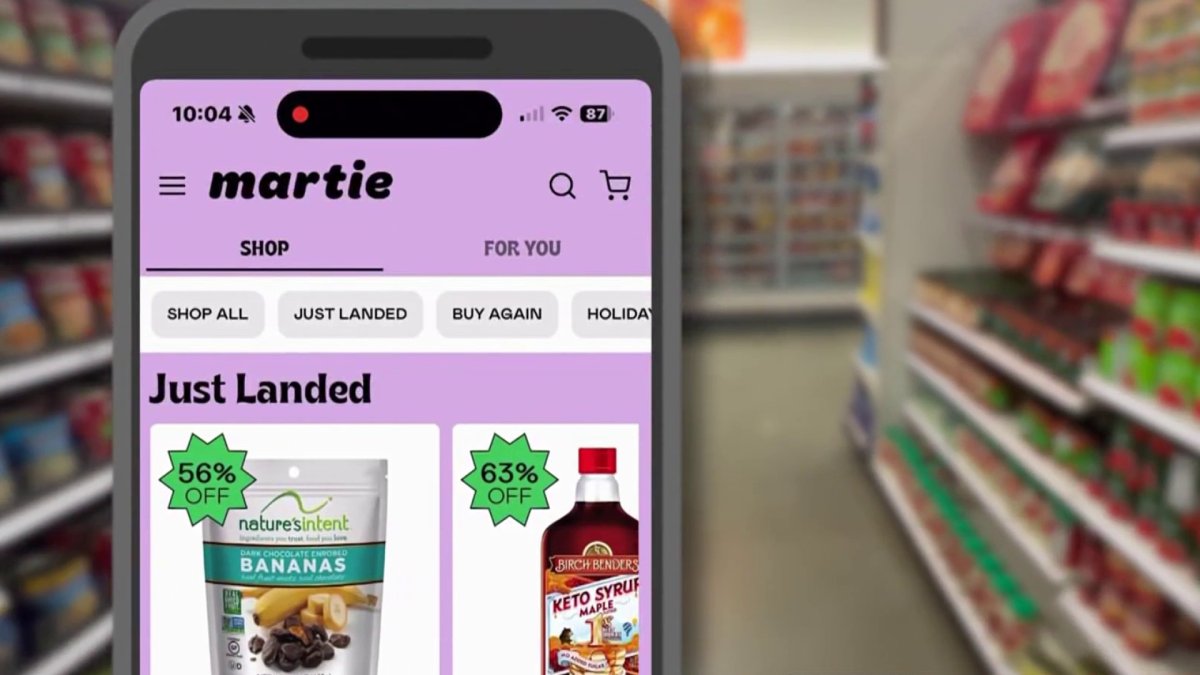
In Livermore, the Travia family is five strong: Jennifer and Nick, plus three kids: Daniel, Jonah, and Emma.
Keeping those five bellies full can quickly empty the wallet. Especially these days.
“Prices have definitely gone up,” Jennifer said. “Overall, the trend is up.” She’s right. Grocery prices have spiked -- with no sign food costs are going back down to where they were. So, Jennifer and Nick shop smart. “I always shop the sales,” Jennifer said.
Recently, the Travias tried something new to find bargains: salvage food shopping. And Jennifer says she’s saving a lot. “At least half of what it would cost in the grocery store.”
Get a weekly recap of the latest San Francisco Bay Area housing news. Sign up for NBC Bay Area’s Housing Deconstructed newsletter.
Jennifer uses Martie.com.
How does the deal work?
“Martie is an online discount store,” said Martie Co-Founder Louise Fritjofsson. “We work with vendors and food producers. We take everything that is overstock, closeouts, surplus, and we sell it in an online store at 30% to 70% off to consumers.”
Local
Fritjofsson co-founded Martie in San Francisco. “I started this company when I was a new mom.” With her co-founder, Kari, in Los Angeles, they set out to help fellow west coasters save. Two years later, they’ve just opened a new, centrally-located Texas warehouse (near Dallas) and are taking Martie nationwide.
“In general, there’s enough food to go around. It’s the going around that’s the issue,” Fritjofsson said. “And that’s where Martie comes in.”
Where does the food come from?
By trucks, trains, ships, and planes, food crisscrosses our country. It rarely just travels from farm to table. In the end, a surprising amount of grub detours to a dead end, like a landfill.
“Sadly, in this country, I think the number is 30% to 40% of the food we grow and produce does not actually go to people. Which is sad for humans; it’s sad for the environment,” said Paul Schiefer, President of Amy’s Kitchen.
Schiefer invited me behind the scenes at Amy’s’ sprawling Santa Rosa factory. (Yes, hairnets and smocks were required. “We take food safety very seriously,” Schiefer explained.)
We watched while Amy’s’ team of 600 cooked up thousands of meals. “We’re making some Thai curry today, putting in that Jasmine rice,” Schiefer noted. “We start with organic ingredients. We use a lot of traditional cooking techniques.”
What’s made here ships to supermarkets coast to coast. Amy’s has shelf space in 43,000 grocery stores.
“We also happen to have, like a lot of food companies, a certain amount of food that we have a hard time selling through our traditional retail networks,” Schiefer said.
After the meals are made, logistics can go sideways. Some issues include: distribution delays, cancelled orders, or printing kinks.
“There are other times where we have to label something specifically for an international market for something unique,” Schiefer said. “Then, for whatever reason that changes, now the product is great food but in the wrong label for what the market needs, and that’s another example of the food we want to get to people ... and isn’t wasted.”
Enter: Martie.
Production kinks = cash in your pocket
Fritjofsson’s team buys that food, advertises it online, then ships to your doorstep the shelf-stable non-perishables that food producers can’t ship to stores. Think of its Texas warehouse as a 40,000-square-feet grocery clearance rack. It’s literally tons of salvage food that Fritjofsson insists is safe to eat. “You will not find products on Martie that are past their ‘best before’ date,” she said.
Louise told me lots of families are finding Martie. “Tens of thousands of families are using our service,” she said. “Our average shopper spends $60 and saves $54.”
To find food for cheap, there is a price to pay: your time. Shipping takes a few days -- though, Martie says it’s free when you spend $50 or more. Another caveat: inventory shifts daily. So, some treasure hunting is required. “We switch out products often. Once it’s gone, it’s gone,” Fritjofsson said. “And that adds to the treasure hunt experience. When you’re shopping.”
Case in point: say your grocery list includes peanut butter or almond butter. “We can’t guarantee you that we’ll have the same nut butter this week as next,” Fritjofsson explained. “But we can guarantee you that we have a nut butter and it’s going to be 50% off.”
We price checked Martie
We fact checked Martie’s prices against identical items in local grocery stores. The deep discounts -- 30% to 70% -- did check out. However, some stuff was tougher to compare. We found some specialty and regional brands for sale, from other parts of the country, that aren’t sold locally.
Some longstanding neighborhood markets, like Grocery Outlet, specialize in food overstock, too. Fritjofsson concedes those regional stores win on instant access. Still, she contends Martie is the only national grocery discounter that’s completely online.
“We are just changing how liquidation is done,” she said.
Back in Livermore, the Travia family is on the receiving end of this liquidation innovation.
Mom banks $379, so far ...
“What you see on the site is what comes to your door,” Jennifer said. Her Martie app says she’s saved $379 and 129 lbs. of wasted food. She’s sold on what she sees as a win-win."
“I think it’s great that we’re saving things from going in the trash that’s still good,” she said.
With that, the kids tore into a fresh delivery -- including some gluten-free cookies.